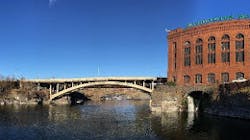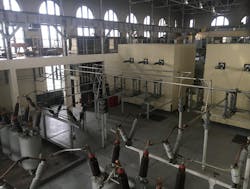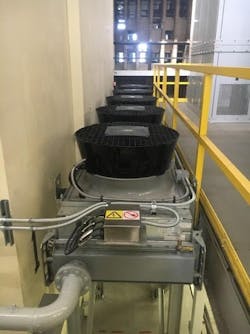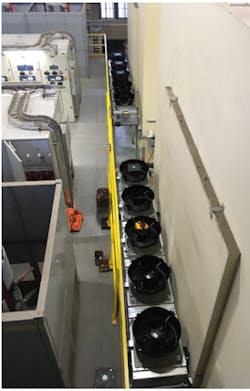Avista Utilities Upgrades Iconic 1910 Hydropower Substation
Avista was founded on clean, reliable hydropower on the banks of the Spokane River in 1889, and still makes up more than 50% of the portfolio serving more than 400,000 electric customers in eastern Washington and northern Idaho.
Avista, based in Spokane, Washington, owns and operates six hydroelectric facilities on the Spokane River, five of which have been operational since 1908. We maintain many historic buildings that are not only vital to delivering power to our customers but also hold a significant place in our city’s history and iconic skyline.
The Post Street Substation, for example, still commonly known as the Washington Water Power building, was designed by renowned Pacific Northwest architect Kirkland K. Cutter in 1909. It initially provided power to Spokane’s streetlight and streetcar system, as well as to households and buildings in the city. In 1979 it was placed on the National Registry of Historic Places.
Updates Needed
Today, the substation is still used as an integral part of delivering renewable, reliable power to our customers though the technology has changed over the last 100 years. But with longevity come the need to upgrade. In this case the cooling system to the four large power transformers located inside the Post Street Substation.
Since these transformers are located inside the substation within fire containment enclosures, they did not have air movement for cooling purposes. The transformers were previously cooled by cycling Spokane River water or city water through a heat exchanger on the transformers. While it was an efficient means of cooling these transformers, it did transfer slightly warmer water back into the river.
A rustic rock bridge was the point of discharging the cooling water into the Spokane River. The bridge is an original design feature of the substation exterior and remains unaltered from its original condition. As it holds both aesthetic and historical value, it was important that the new cooling project also find a way to keep this water feature intact.
Design-Build Arrangement
With both of those goals identified, engineering and design began with Avista engineers and Delta Star, the company which manufactured the transformers. Under a Design-Build contract, Delta Star provided the technical expertise and professional engineering services for engineering, materials and field service required to retrofit two Upper-Level Substation transformers and two Lower-Level Generation transformers cooling systems.
Cooler Conversions
Utilizing a design build and prefabricated system expedited off-site construction time. The main construction of the new coolers onsite began with removed water-cooled Oil Forced Water Forced (OFWF) fed from the river, to Oil Forced Air Forced (OFAF). The OFAF coolers eliminate the discharge of cooling water into the river. In conjunction with Delta Star’s design and prefabrication of the new coolers, Avista engineers designed the low voltage electrical supply, instrumentation and controls design, as well as, building ventilation and heat exhaust. We designed air intake and exhaust systems to ensure there would be no impacts or alterations to the historic brick or windows of the Post Street building.
The remaining demolition of the pre-existing cooling system and building drainage improvements was performed by a local construction company. Roof vents on the gable ends of the penthouse mezzanine were color matched for historic purposes. Finally, an additional air circulation fan on the substation floor hatch to draw air from the basement and direct it toward the roof vents.
New Water Source
To preserve the rustic rock water feature, Avista looked for another source of water that could maintain the aesthetic. Given the building’s proximity to the river, there is significant groundwater leakage into the building from the conduits on the east side of the building. All of that water is collected and discharged at the rock bridge water feature. The 115 kV substation project included efforts to re-engineer the east conduit drainage in order to provide the water feature with “natural and historic” groundwater and get away from running and maintaining a large pump.
During any project, we strive to maintain existing structures and their historic character. This is in alignment with our Spokane River Historic Properties Management Plan developed as part of our 50-year Spokane River license approved by FERC in 2009.
Hydropower
Today, six Avista-owned hydroelectric facilities on the Spokane River and two on the Clark Fork River in Idaho and Montana provide nearly half of Avista’s diverse energy mix which includes water, wind, biomass, natural gas, solar and coal. Hydropower is clean and inexpensive. A diverse energy mix helps keep our prices among the lowest in the nation. It's also why Avista is ranked one of the cleanest utilities among the hundred largest power producers in the United States. It's how we'll be able to continue to provide reliable energy to our customers now, and well into the future.
About the Author
Brett Nephew
Brett Nephew is a mechanical engineer at an operating division of Avista Corp. Brett has over 15 years’ experience in heavy equipment and applications and has worked for Avista for since 2017. Brett holds a Bachelor of Science in mechanical engineering with an emphasis on materials from Eastern Washington University.
Michael Truex
Michael Truex is a project manager at Avista Utilities and brought extensive utility industry experience to Avista in 2015. Michael holds a Bachelor of Science in construction engineering technologies from Eastern Washington University and a Master of Business Administration from Whitworth University with a concentration in executive leadership.




